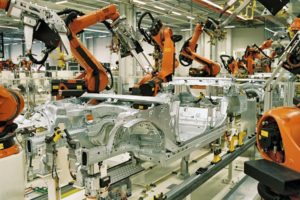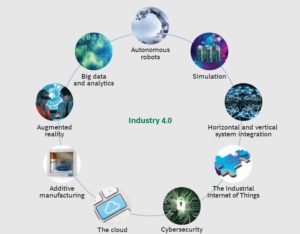Even if different interpretations are possible, finally the term “Industry 4.0” converges on a single target: an innovative organization of physical and digital resources aimed at enhancing the competitiveness of the european manufacturing industry.

The German economy’s need of facing low labour cost Countries’ competition, while keeping both the employment level and salaries high, is at the origin of the “Industrie 4.0” plan introduced in 2011 at the Hannover Exhibition, based on the pillars of nine enabling technologies and aimed at innovating conventional manufacturing processes. As written, the strategic goal consists in maintaining the high profitability of the resources used in production, qualitatively synthesizable by the ROCE (Return On Capital Employed, ratio between EBIT/Capital Employed) index, chosen among the others by the Consulting company Roland Berger to break up the effects of the two factors (EBIT/Value Added on one hand and Value Added/Capital Employed on the other hand), which influence the profitability of the capital employed, the margins of the operational management and the productivity of investments. The Roland-Berger analysis, in its latest updates, identifies the digital manufacturing as an innovation process that extends the two conventional strategic positioning options at equal ROCE values, investments in automation or reduction of the labour cost, introducing a new growth trajectory where the technological innovation can match mass customization and plant flexibility, extreme automation and high wages. Along this development path, via the digital innovation of manufacturing processes, it is possible to position on new curves at higher profitability, which in the future would lead to a growth by around 10 percentage points of ROCE, from 18% to 28% by about 2035.

The operational planning is the base of all
Setting the useful financial index aside, the strategic target must anyway result in an operational planning, hinged on some main innovation drivers: interactive and traceable products, inter-operational processes and virtualization of physical resources. Drivers can be activated by a targeted recombination of enabling technologies attainable “from the shelf” by opportune vendors, diffused thanks to an institutional policy of widespread sensitization (the networks of Competence Centers and of the Digital Innovation Hubs provided for by Calenda Plan and by similar European initiatives), to adapt them afterwards to the distinguishing core competences of each single company and to create new business models, as integration and not in replacement of conventional ones. According to this vision, innovation must not be meant as ‘disruptive’ in the standard sense, as often promoted by the market of vendors, concentrated and grouped in consortia, but it can neither be framed in the perimeter of the conventional incremental innovation, dominating in Industry 3.0. The digital layer, which anyway already permeates by inclusion all the companies provided with ICT technologies, must simply aggregate coherently in a “middleware” layer that mediates the physical ‘core’ processes of the company, sutured in real time with the relative virtual “avatars”, creating the nervous motorway that connects advanced transactions of products and markets, both digital. The entrepreneur of the future, of a next future, exploiting the connective fabric created by the “middleware”, will organize the resources and the transactions on what some people call ‘platform’, where they completely define the technological and managerial characteristics of processes and products before undertaking the final physical modification. The first platforms were implemented around already digital, or easily digitized, value flows and products (like in the music by iTunes or in the books by Amazon, to mention the cases that have become more daily for us), where the managers of the sector platform have broken the entrance barriers of Porter’s investment costs (thanks to the fast scalability of platforms) to gain more value than conventional manufacturers using it, music or book publishing giants that, fearing to cannibalize their consolidated models, have not innovated towards that direction.

Beyond the segmentation of traditional markets
“First takes it all” seems to be the configuration law of the digital market, which overrides the segmentation of traditional markets where it was anyway possible to gain a market share with a different strategic ranking. It is not surprising the manufacturing sector’s unwillingness to imagine and adopt new business models, the real novelty of the digital manufacturing revolution, since already expected by numerous strategic consulting investigations, which position the manufacturing industry in the last places in terms of cultural permeability to the digital innovation. The material culture of the product/process and of the control of the relative “know how”, to be able to satisfy customers’ specifications with better times, costs and quality than competitors, have been the strongholds of our manufacturing industry but today the backward migration of digitalization instances through the entire chain, starting from the final market to trace back all previous phases, urges also the companies that are most distant from the final market to adopt a digital culture according to a vision displaced towards the B2C. On the other hand, those manufacturers of automated plants, typical of B2B segments, which could boast a privileged access to the final market, had already adopted a long time ago this “consumer oriented” and not only “technology oriented” approach. Tetrapak, for instance, managing for years an exclusive product, could draw information and data directly from the final market and use them in User Experience processes to adapt the technologies to the requirements of the final market and not only of intermediaries. Tetrapak has not waited for its customer’s specifications, the drink producer, but it has anticipated them, proposing them the relative solutions. Today, thanks to the availability of diffused and cheap data access (the so-called “Big Data”), it is easier to dialogue with the final market, for instance through CRM systems and customer engagement processes, and facilitating the transition from a “know-how” response to a “know-why” proposal it is possible to anticipate the specifications, maybe proposing new ones. Digital transaction modalities on the final market are going back along the entire manufacturing chain and generate metamorphoses on the current architectures of productive plants, whose architectures must be

adapted using the discussed “middleware”.
The solution: the Smart Factory
The so-called “Smart Factory” is the result of the convergence of the data flows coming from the digitalized market with the data provided by one’s own processes, they too digitalized. On the other hand, processes are already virtualized in the organization of Industry 3.0, but in modality 4.0 the interaction increasingly moves towards the “real time”. The digital manufacturing shortens the spatial and time distance between the physical modification of the product and its informative structure, approaching -up to the complete suture- the generation and the immediate use of data, of any kind and origin, external or internal, from the customer engagement of CRM to the operational scheduling of MES and the database of after sale service reports, coordinating along a new operational synchrony the traditional processes of new product development, of management of operations, of maintenance and after sale. Then, as business model, emerge the new trends reported as mass customization, of CPS and of predictive maintenance, clearing the field from the confusion in course between computerization of processes and their digitalization.

The digital twin
General Electric, which was at the base of the American version of the digital manufacturing called “Industrial Internet”, has launched the “digital twin”, the digital simulation of a manufacturing plant towards the “on-line” modality. These simulations have been used for a long time through software of Industrial Physics in design area and of virtual commissioning, but thanks to the support of IIoT devices, of elastic calculation power and of M2M networks, it is possible to use them also for the operational management, receiving as inputs the machine state signals, and to launch simulation runs to foresee the line behaviour within the successive time frames, in order to manage eventual unexpected events and anomalies. The “digital twin” is an example of interactive process that, like interactive products, are new items not perfectly defined, yet, astride the physical and the digital. Besides, it Is necessary to generate new competences and approaches that manage the business innovation through new models of process and of product, processes in which, it is worth reminding, physical performances will not diminish to the detriment of digital ones but– on the contrary – they will be even more highlighted, to the same extent according to which, to be able to compete in the phase 4.0, the company must reach the excellence in the phase 3.0. In these models, the previous neat separation between product and service vanishes, in the convergence of the two opposite trends of “servitization of manufacturing processes” and “materialization of services”. The value crushing towards manufacturing processes more oriented to services, already highlighted since’92 by the “smiling curve”, can now be enhanced by digital technologies (Fig. 5). The possibility, for instance, of selling no longer a manufacturing plant but its output (number of blisters instead of a blistering line, for instance), according to the Rolls-Royce model of the “Power by the Hour”, today is enabled by the control of the system behaviour during its entire life cycle through the data connection and analysis, and this model might be proposed also by players outside the packaging sector, misleading the traditional leaders through the use of innovative “platforms” previously described. In the service area, for instance of insurances, the availability of smart devices to monitor single lifestyles are already used to build personal risk profiles, supporting the supply customization through interactive products. In both cases, it is necessary to create suitable profiles that succeed in modelling new business architectures around these “hybrid objects “, with roles often identified in the CDO, “Chief Digital Officer”: it is necessary they receive a strong mandate by the management to break transversally silos innovation mechanisms and to manage digital enabling technologies not only and reductively in view of technological innovation but especially of strategic innovation one.



